#Music streaming app development
Text
Gamification and Music Apps: Engaging Audiences in 2023
The music industry has undergone massive changes in the past decade. Streaming services like Spotify and Apple Music have become the dominant way people consume music. But with increased competition, music streaming apps need creative strategies to engage and retain users.
“Enter gamification.”
Gamification has successfully engaged users across industries - from fitness apps like Nike+ to language learning platforms like Duolingo.
It also involves applying game design elements to non-game contexts. This could mean including points, badges, leaderboards, or other game-like features in an app.
When done right, gamification offers many benefits for music streaming app development in 2023:
## Boosting Engagement and Loyalty
A key challenge for music streaming apps is keeping users engaged over time. Entertainment options have expanded significantly in recent times.
Gamification gives users incentives to keep opening the app. Tactics like daily streaks and rewards encourage habit-building.
For example, Spotify gamified exercise by partnering with brands like Nike. Users could earn badges for running certain distances. This boosted engagement during workouts.
Leaderboards drive competitive instincts. People will stream more music to top their friends' listening totals.
These techniques increase loyalty. A study found gamified users spent 9% more time in apps than non-gamified users.
Gamification Tactic
Example
Benefit
Daily Streaks
Spotify - Listen 7 days in a row
Habit-building
Badges
Nike+ Run Club - Run 5km badge
Engagement during activity
Leaderboards
Friends' listening totals
Competition drives streaming
## Creating a Personalized Experience
Music taste is deeply personal. Gamification allows apps to tailor experiences to different users.
Personality quizzes help music streaming apps understand listeners' preferences. Streaming services can then recommend music based on quiz
results.
For example, Pandora uses the Music Genome Project. This database analyzes songs by musical attributes like melody and rhythm. Pandora quizzes users when they create stations to serve personalized tunes.
Badges reward users for listening to new genres or artists. This encourages discovery outside traditional tastes.
## Turning Music into a Journey
Music often accompanies life's journeys. Apps can gamify learning an instrument, discovering new genres, or achieving health goals.
For instance, Yousician makes learning guitar into a game. Users play along to songs and earn points for hitting the right notes. This transforms a frustrating skill into a rewarding journey.
Rocksmith gamifies learning bass, guitar, and ukulele. The app provides feedback on technique and tracks progress. This structure keeps beginners motivated while advancing their skills.
Gamification works for niche interests, too.
Adsic app rewards users for learning about jazz greats like Miles Davis. Unlocking facts and stories offers a deeper connection with jazz.
## Social Sharing
Since music taste defines identity, gamified sharing on social media can significantly boost engagement.
Apps like Spotify enable sharing listening activities, playlists, and concert events. Users earn badges for social engagement.
Integrating with platforms like Facebook, Instagram, and Snapchat encourages sharing music discoveries. Users can display their avant-garde tastes or Spotify-wrapped yearly statistics.
Social feeds within music streaming apps also stimulate engagement. Showing friends' listening activity and playlists inspires users to listen more.
## Keeping Things Fresh
Gamification relies on introducing new elements to sustain engagement. Apps should re-examine features regularly to prevent stagnation.
Limited-time quests, such as streaming a daily mix for a few continuous days, encourages brief bursts of activity. Seasonal badges also prompt engagement around events like the Grammys.
To analyze impact, companies A/B test gamification features. For example, they could trial a points-based system against a badges-only system to see what drives more streaming.
Continued innovation is crucial. Gamification that becomes stale will see declining use. Companies should solicit user feedback and telemetrics to guide iterations.
Risks to Consider
Gamification does not guarantee automatic success. Poorly executed gamification risks annoying users or seeming gimmicky.
Badges and points should meaningfully recognize milestones. Random rewards or bureaucracy frustrate users.
Leaderboards must connect to aspirational identity. Few people will compete without some personal value attached.
Constant notifications and alerts from gamification can irritate users. Apps should allow customization of prompts and incentives
Music apps should ensure gamification encourages organic engagement rather than continual in-app purchases.
Gamification should ultimately enhance the core user experience. It should not serve as a distraction or undermine the enjoyment of music.
In 2023, expect music apps to explore innovative technologies like AR for more immersive gamification experiences
Conclusion
Gamification allows music streaming apps to boost engagement, loyalty, and discovery in 2023 and beyond. However, apps should be wary of overusing gamification as user fatigue could set in. As the technology advances, expect gamification tactics to become even more immersive and personalized through innovations like virtual reality and AI-enabled recommendations. Music apps that creatively employ gamification will continue engaging users on their lifelong journey of musical discovery.
To maximize impact, companies must tailor gamification and allow customization to appeal to diverse users - from those motivated by rewards to those who prefer a straightforward experience. Gamification should be one of many tools to engage users rather than a one-size-fits-all strategy.
If you need help engaging audiences through your music app, reach out to Consagous Technologies, a leading music streaming app development company.
With expertise in gamification and mobile app development, Consagous can craft the perfect solution for your needs. Get in touch with us today!
0 notes
Text
The Role of Analytics in Music Streaming App Development
Music streaming app development is highly competitive. Staying ahead of the curve is quite difficult for new competitors, especially when the apps like Spotify are in the market. But we can confront this with data analytics.
Do you know how Spotify became the #1 Music streaming application worldwide? The answer is data analytics. It helped Spotify to stand out as a strong competitor in the market. Moreover, not only Spotify but also other competitors, such as Apple Music, Pandora, Songza, etc., use data analytics to compete in this high competition of music app development.
However, no matter which industry you are in, a data analyst always helps businesses to optimize their operation by pinpointing downsides, leading to optimum utilization of resources and efficiency in the system. As per Splunk, businesses prioritizing data see average yearly revenue growth of 5.32% due to improved data utilization. In short, data analytics is a powerhouse of business that has the capabilities to make or break your business.
If you are also considering developing a music streaming application, this blog will help you. Here we will discuss the benefits of Music Streaming App development, which will help you to understand how data analytics plays an essential role in Music Streaming App Development.
5 Benefits Of Analytics In Music Streaming App Development
1. Personalize the customer experience!
If you aim to build top-notch online music streaming software, the only step to take you up is to provide a seamless customer experience. For this, you can collect personal data from many different channels, including e-commerce and social media. This helps you understand the audience’s taste, and you can develop your music streaming solution as per your target audience’s taste. It is an integral approach that you can apply to gain insights into customer behavior and provide a more personalized experience.
2. Inform business decision-making
You can employ data analytics to inform decision-making and reduce financial losses. Prescriptive analytics can propose how the online music streaming software should respond to these changes, while predictive analytics can foresee what might happen due to these changes. Furthermore, you can use data analytics tools to assess the performance of the adjustments and visualize the outcomes after gathering sales data on the modified items. This will assist decision-makers in deciding whether to implement the changes or not.
3. Mitigate risk and handle setbacks
Developing an app is full of risk. But with data analytics, you can better evaluate hazards and implement preventative actions. It helps to identify the target audience for your online music streaming software and their preference. The company might use this information to decide how we can cut the competition and do better things by understanding customer needs and preferences.
4. Continuously updating its system
Music Streaming App Development has become a highly competitive industry. Companies in this sector must continuously update their apps to keep up with the ever-changing market trends. This is where data analytics works as a game changer. With the help of data analytics, developers can gain insights into user behavior and preferences, which can be used to improve the app. It also allows developers to understand how users interact with the app. By tracking user behavior, developers can determine which features are most popular and which areas of the app need improvement.
5. Digitizing the taste of the user
With the help of data analytics, music streaming solutions can also gain insights into the user's listening habits, such as the time of day when they listen to music, the type of devices they use, and the genres they prefer. This information can be used to optimize the app's performance and ensure that it provides the best possible experience to the user. Additionally, data analytics can help identify the most popular songs, artists, and genres among the users, which can enhance the app's content library.
Conclusion
Music Streaming App Development companies constantly seek ways to improve their services and stand out. One way they are doing this is by utilizing data analytics to update their music streaming solutions continuously. Data analytics can help music streaming apps stay competitive by monitoring what is happening in the music industry. Furthermore, you can stay ahead of the curve and ensure your app offers the latest and greatest features.
If you are looking for a reliable Music Streaming App Development company that can help you do in-depth data research and build cutting-edge online music streaming software. We can help you. Consagous is the leading Music Streaming App Development company that will turn your imaging into reality!
0 notes
Text
#best mobile app development company#mobile app development agency#music streaming app development#cost to create music streaming app like soundcloud#Soundcloud app development Cost
0 notes
Text
On-Demand Music Streaming App Development
With the rising demand for technology around us, the market of the on-demand industry is undoubtedly increasing at a rapid state. Consagous Technologies is a renowned name in the IT industry, offering best-in-class on-demand music streaming app development solutions. For better understanding of music streaming mobile apps, visit Consagous.co
https://www.consagous.co/trending-solution/music-streaming-app-development
0 notes
Text

🎶 Winamp, the iconic media player, first captured our hearts back in 1997. Developed by Justin Frankel and Dmitry Boldyrev of Nullsoft, Winamp became a sensation with its customizable skins, music visualizations, and robust media library. By 2001, it boasted over 60 million users, making it one of the most downloaded Windows applications of its time.
💾 From its early days as a trailblazer in the MP3 era to its recent revival under the Llama Group (formerly Radionomy), Winamp has evolved while maintaining its core charm. The latest version, 5.9.2, released in April 2023, continues to support a thriving community of enthusiasts.
👑 Exciting news is on the horizon as Winamp prepares to go partially open-source on September 24, 2024, paving the way for new innovations and a resurgence in its popularity. Stay tuned for what’s next in the Winamp legacy!
#techtime chronicles#old technology#old tech#tech#technology#companies#electronics#information technology#technews#corporations#winamp#aol#america online#llama group#radionomy#music#music players#music platform#mp3#streaming#mobile app development#apple music#software development#software#softwaredevelopment#early web#y2k aesthetic#old internet#old web#2000s web
10 notes
·
View notes
Text
How much does it cost to develop a music streaming app like Deezer. Get insights, tips, and estimates for your project.
0 notes
Text
Innovative Music Streaming App Development Company for Modern Audiences

Our innovative music streaming app development company caters to modern audiences, delivering cutting-edge solutions that redefine how you experience music. We specialize in creating user-friendly, feature-rich apps that seamlessly integrate the latest technologies. From personalized playlists to high-quality streaming, our expert team ensures a top-notch listening experience. Trust us to turn your vision into a reality, providing you with an app that resonates with today's music lovers and keeps them coming back for more.
0 notes
Text
How Does Blockchain Impact Music Streaming Apps?
Have you ever wondered how that favorite new song gets from the artist's studio onto your phone? Read on to explore the technical world behind the music streaming app!
Streaming services have revolutionized how we discover and listen to music. While many appreciate the convenience and vast selection offered by music streaming apps, the intricate technology that powers these platforms often remains behind the scenes, unexplored by the average user.
From recording licensing deals to distributing royalties, running a streaming platform involves intricate scientific processes. Blockchain has emerged as an innovative solution to simplify music data and payments.
Curious how blockchain could unlock the future of Music Streaming App Development? Let's unpack the tech:
A Quick Peek Under the Hood
Before we dig into blockchain, let's pop the hood on current music streaming app technology:
Streaming Platform Backend

Even at internet scale, the technical nuts and bolts of a music streaming app are daunting!
This is where blockchain comes in.
Understanding Blockchain Technology
Overview of Blockchain: Distributed Ledger Technology
A blockchain is a cryptographically secured distributed ledger that records transactions in an immutable and verifiable manner. It relies on peer-to-peer networking, asymmetric cryptography, and consensus mechanisms to validate transactions in a decentralized way.
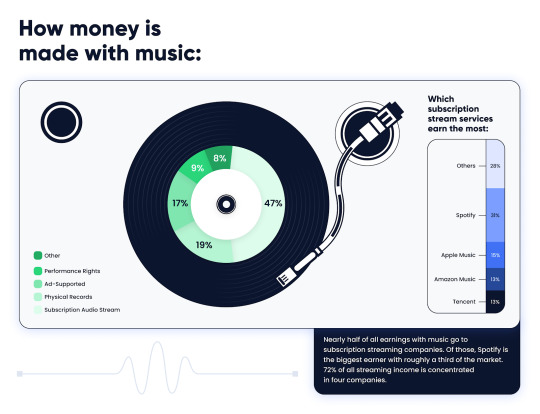
Blockchain Data Structure: Blocks and Transactions
The blockchain is comprised of three main engineering elements: blocks, transactions, and the distributed network. Transactions containing details like sender, receiver, and amount are grouped into blocks. Each validated block is cryptographically chained to the preceding one. This creates an irreversible chronological chain of transactions.
Technical Elements: Decentralization, Cryptography, and Consensus Mechanisms
Decentralization mean no central authority controls the network. Cryptographic functions like hashing and digital signatures ensure security. Consensus mechanisms like proof-of-stake allow decentralized nodes to agree on the network's state. These core precision elements enable blockchain's resilience and transparency.
Smart Contracts: Self-Executing Code on the Blockchain
Smart contracts are programmatic scripts containing business logic that automatically execute when specified conditions are met on the blockchain. They are deployed to and executed by the decentralized network. The determinism and isolation of the execution environment ensures verifiable and predictable computation.
For on-demand music streaming, smart contracts enable automated royalty distribution and rights management.
Technical Impact of Blockchain on Music Streaming Apps
Enhancing Royalty Distribution Efficiency
Technological Details of Smart Contract-Based Royalty Distribution
Smart contracts can be programmed to distribute royalties automatically based on pre-defined rates and usage metrics. Payment rules and recipient addresses are encoded, which enables real-time payment processing without manual intermediaries.
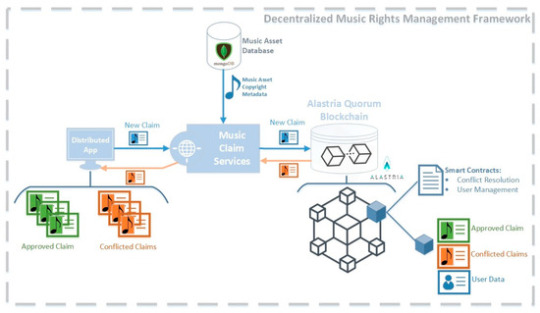
Real-Time Payment Processing
Royalty distribution can be technically optimized to process micro-payments in real-time each time a song is streamed. This granular approach increases accuracy and allows artists to receive instant payments.
Eliminating Intermediaries and Reducing Latency
With an automated system handling royalty calculations and payments, slow manual processing by intermediaries is reduced. This analytical innovation enhances the timeliness of royalty delivery across complex supply chains.
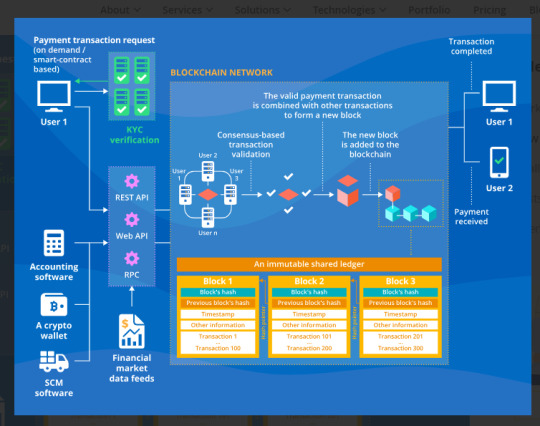
Transparency in Licensing and Rights Management
Immutable Recording of Copyright Ownership
Blockchain's immutable ledger allows copyright ownership and licensing deals to be indelibly recorded. This single source of truth provides clarity on rights ownership to platforms, artists, and publishers.
Automation of Licensing
Licensing terms can be technologically automated by encoding them into smart contracts. Any Music App Development company could instantly verify rights ownership and licensing status for any track via the blockchain rather than through opaque negotiations.
For example, Dot Blockchain has developed a systematic architecture for recording and automating usage-based licensing on media blockchains.
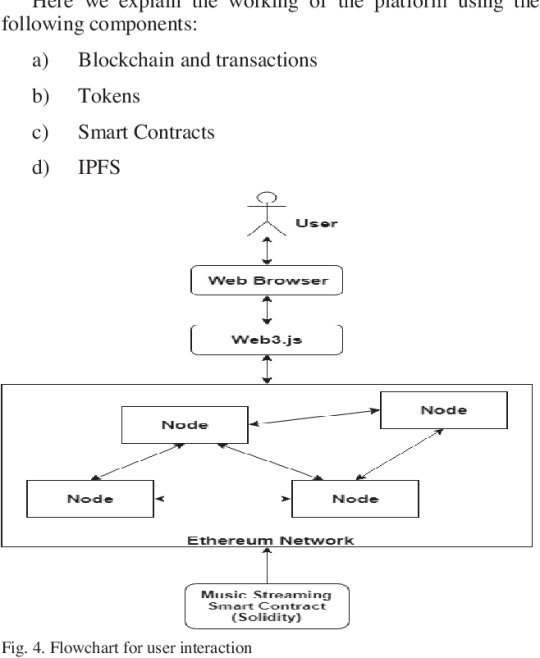
User Experience Enhancements
Seamless Payments and Microtransactions
Music Streaming App can leverage blockchain payments to allow frictionless microtransactions between artists and fans for content and experiences.
Real-Time Analytics for Artists
Artists can be empowered through real-time analytics of fan engagement and royalty data tracked on-chain. Music Streaming Platforms like Revelator provide these procedural capabilities.
Fan Engagement through Tokenization
Loyalty schemes and fan experiences can be built using complex tokenization mechanisms like NFTs for unique engagement opportunities.

Key Differences Between Traditional Music Systems and Blockchain
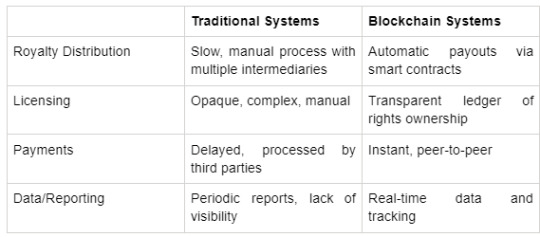

Blockchain Music Streaming App Services
Several startups are already developing blockchain-based music streaming platforms as alternatives to popular apps like Spotify.
For instance, Audius is a streaming service and decentralized protocol that connects artists directly with fans. Artists can share their music and be compensated immediately with the platform’s native AUDIO token. Fans can support artists through subscriptions and tips. Over 100,000 independent artists have joined Audius to date.

Other examples include PeerTracks and Musicoin. These platforms demonstrate how blockchain enables fairer value exchange and compensation for creators in music streaming. As blockchain achieves mainstream adoption, decentralized streaming services could potentially disrupt incumbents.
Limitations of Blockchain in Music Streaming Apps
While blockchain promises many benefits, there are limitations to consider:
Scalability – Blockchains like Ethereum can currently only process 10-20 transactions per second.
Major Music Streaming App Development companies process millions of streams per second, so blockchains need greater scalability to support high volumes. Meanwhile, the computational demands of smart contract execution also limit scalability. Leading music streaming platforms handle millions of plays per second - a massive scalability gap.
However, solutions are emerging, including Ethereum's shift to proof-of-stake consensus, layer 2 scaling protocols like state channels, alternative high-speed blockchains like Solana, and sharding mechanisms. Though still maturing, these innovations illustrate pathways to improve blockchain scalability to meet mainstream demands significantly.
Volatility – Cryptocurrency payments lead to exposure to volatile markets. Appropriate stablecoin solutions are needed to limit risk.
However, stablecoin technology is rapidly evolving through algorithmic designs, collateralization models, and decentralized governance to stabilize valuation. These innovations can potentially reduce the barriers posed by crypto volatility.
Adoption – Moving an entire industry to a new paradigm is challenging. Mainstream adoption will take time, education, and proper governance mechanisms.
Ongoing technology and design improvements can enhance the onboarding process for users.
Centralization – Ironically, many blockchain-based platforms are still centralized in some aspects. Truly decentralized governance is difficult to achieve initially.
Regulatory uncertainties remain a hurdle - decentralized platforms must still comply with copyright laws, licensing rules, royalty rate regulations, and territorial restrictions. Technical innovation alone cannot fully decentralize music streaming governance without legal evolution. However, blockchain communities continue working to increase decentralization through both technological and policy advances.
The potential is clear, but it will take time for blockchain to mature and see significant real-world adoption at scale across music streaming.
Conclusion
As you’ve seen, Blockchain technology presents a fascinating opportunity to evolve the systematic architecture of Music Streaming App Development. Though still facing growing pains around scalability and user adoption, blockchain allows for an open, transparent, and creator-driven music ecosystem.
Integrating blockchain in music streaming appsunlocks valuable, proficient capabilities like instant royalty processing, verifiable licensing rules, and direct fan engagement opportunities. As the technology matures, we can expect more music streaming app startups to harness blockchain to address industry pain points.
Mainstream adoption by major streaming players may take time, given the skillful lift. However, early innovators like Audius highlight the progress and possibilities.
The road ahead is challenging, but music fans, artists, and technologists alike should pay attention as blockchain lays the foundation for the future of music streaming app development.
For those excited about building the next wave of music innovation, partnering with experienced professional teams can help bring blockchain-powered music app ideas to reality. A leading music streaming app development company like Consagous Technologies has the expertise to handle complex blockchain integrations and deliver successful streaming app projects.
By collaborating with proven, knowledgeable talent, the possibilities of blockchain-transforming streaming become closer than ever!
Your Questions Answered
Q: What's the hype around blockchain and music streaming apps?
A: Blockchain has the potential to shake up how music streaming apps work behind the scenes! It offers a transparent, methodical framework to automate royalty payments, record copyright ownership, and create new ways for artists and fans to interact. The hype is around blockchain, making the music streaming app development business more fair and open.
Q: Can blockchain really fix the issues around compensating artists fairly?
A: While blockchain can make royalty distribution more transparent through smart contracts, it does not inherently address the underlying revenue splits, which many argue unfairly favor platforms over artists.
Blockchain provides the technological infrastructure to enforce royalty payments in a timely, transparent way. But, the rules and percentages programmed into the smart contracts could still shortchange artists.
Q: How would blockchain change the user experience of music apps?
A: Listeners could enjoy seamless in-app micropayments, unlock special content through NFT tokens, get rewards for promoting songs, and more. Artists would gain real-time analytics on fan engagement powered by blockchain's transparent data.
Q: Which big music streaming platforms are using blockchain now?
A: None have embraced blockchain in its entirety. But startups like Audius have working models showing blockchain's potential.
Major players are keeping an eye on blockchain, but mainstream adoption is still a work in progress.
Q: How can blockchain support independent artists?
A: By reducing platform dominance and moving interactions to the blockchain, independent artists could gain more ownership over relationships with fans and fair compensation. It offers technological paths to sustain independence.
0 notes
Text
How to Monetize Your On-Demand Music Streaming App?

As an on-demand music streaming app owner, you definitely want to earn from what you have. After all, you have invested your hard-earned money in Music Streaming App Development.
If you are clueless about how you can monetize your music-streaming mobile apps,
Don't worry; we have gotten together all the possible ways through which you can monetize your app!
Writing songs, spending time in the studio, or hearing that first mix is far more enjoyable than learning to make money from music. Music monetization isn't the most important aspect of what you do, but it will help you make money to support your hobby.
The ways to make money with music have developed over time, just like musical genres have. Artists used to sell CDs before there was online distribution. Before that, there were cassettes, LPs, etc.
Being a successful musician requires monetization. Let’s understand what music monetization is.
What is music monetization?
Music monetization is a technique for musicians to earn money online. You presumably already understand the term "monetization" in the context of social media or video income, yet it occurs across a wide range of businesses.
Monetization in the music business might be challenging. An artist must be the rightful owner of the royalties to profit from a song. When music is sold or otherwise monetized, royalties are the sum given to the song's owner. An artist must be the rightful owner of the royalties to profit from a song.
For instance, a movie must pay royalties for the music rights if they want to utilize your song at the end of their piece of music.
Royalties are also categorized into two separate copyrights.
Copyright for the music belongs to whoever created the melody and lyrics. Copyrights for audio recordings: usually belonged to the record company and the recording artist.
Advertisements and membership fees fund most music streaming services. Advertisers pay streaming services like Pandora or Spotify to provide you with ads in addition to the music you're listening to on their platform. The cash goes straight to the service if you want to pay a monthly charge.
Royalties are how artists do get paid when they use streaming platforms. According to a Spotify business filing, the average per-stream payout ranges from $0.006 to $0.0084. Consequently, while streaming can expose your song to millions of listeners, it could be more lucrative.
Types of Music Streaming Services
There are mainly three types of music streaming services:
Radio
On-Demand Music Streaming
Cloud Storage
How To Monetize Your Music Streaming Mobile Apps?
You can monetize your music streaming mobile apps in various ways. Here we have talked about some most effective methods, which include:
Freemium Model
Apps offering free versions with limited or no access to premium features are unquestionably favored over those not.
This does not imply that restricted information is not protected; only a portion is visible to everyone. For instance, Spotify started its service using a freemium business model, but it's important to note that it was ad-supported.
This business approach brings more users to your website. Although they may now be freemium members, they are more likely to become future paying customers.
In-Stream Ads
Any service's revenue strategy must include advertisements. Ads create spaces for triggering income generation. Display Ads and In-Content Ad Streaming are two subcategories of advertisements in music applications.
Display advertising is visual advertisements that appear on the screen briefly between, before, or after music. These advertisements can often be broadcast every few minutes. While in content streaming, brief audio or video snippets play before or after the music. This display and streaming ad strategy is effective under the freemium business model.
Subscriptions Model
You can drive customers to move from the free, ad-supported plan to the premium, ad-free video subscription plan, starting at a low price, after you have enough freemium subscribers who truly enjoy your audio broadcasts and platform experience. You may create OTT price plans for various target audiences, including families, students, and others.
Many music streaming services provide monthly plans granting users unlimited music access. This monetization method enables businesses to generate income regularly. Since the music industry must periodically pay for licensing, it is the most often used type for On-Demand Music Streaming App. In the subscription model as users get more perks and more substantial incentives in the subscription model, they are most likely to opt-in for this model.
4. Presence On Multiple Platforms
When considering how streaming services generate revenue, the main factor is that they must be accessible on all platforms, including smartphones, smart TVs, websites, gaming consoles, and others. You can only provide your carefully chosen material to the widest possible audience. Additionally, this will assist you in growing your consumer base and lure them to watch how you want them to.
5. In-App Purchases
In-app purchases are necessary for all forms of income creation. It is the most profitable method of app monetization. Users can choose whatever they want and only pay for that choice.
Users sometimes conflate subscriptions with in-app purchases, but it's important to remember that subscriptions include everything offered at that pricing point.
While in-app payments allow customers to choose only the premium options—such as playlists, high-quality access, and improved user interface—that they want to pay for. Conversely, the app firm may quickly profit from services allowing individual purchases, which generate greater earnings than bulk transactions.
Tech Stack For On-Demand Music Streaming App
The total success of your Music Streaming App Development in the cutthroat environment is determined by its technological foundation. Modern technology support for the app may set your company on the route to success while assuring optimal ROI.
The most well-known music streaming applications for iOS and Android use some of the simplest technologies and frameworks in their technology stack.
Front-end- CSS, Java, Swift, Bootstrap
Back-end- Ruby, Angular JS, Python, JavaScript
Cloud- AWS, Azure, Google
Notifications- Twilio, Push.io
Device Verification- Nexmo, Twilio
OS- Android, iOS
Database- Postgress, Hbase, MongoDB
Live Analytics- Hadoop, Cisco, IBM
DevOps- Datadog, TestFlight
How Much Does it Cost to Develop a Music Streaming App?
We've given you all the information you need to estimate the Music Streaming App Development cost. Hence, the cost of music streaming software with key functionalities for only one operating system, such as iOS or Android, ranges from $12,000 to $30,000. Additionally, a music streaming app would cost you between $25,000 and $35,000 if you want a cross-platform app with all the contemporary features & third-party services.
In A Nutshell
We hope you now better understand how to monetize your music-streaming mobile apps. The benefit of monetization of the On-Demand Music Streaming App and the price of creating a music streaming app is that you may experiment with different approaches to determine which works best for you. The secret is always to emphasize your Music Streaming App Development solutions that grab your audience's attention in the ever-changing market. If you want to develop a feature-rich app that can be easily monetized, contact us to hire our experienced music app developers to turn your idea into a profitable business.
Original source: https://www.consagous.co/blog/how-to-monetize-your-on-demand-music-streaming-app
0 notes
Text
0 notes
Photo
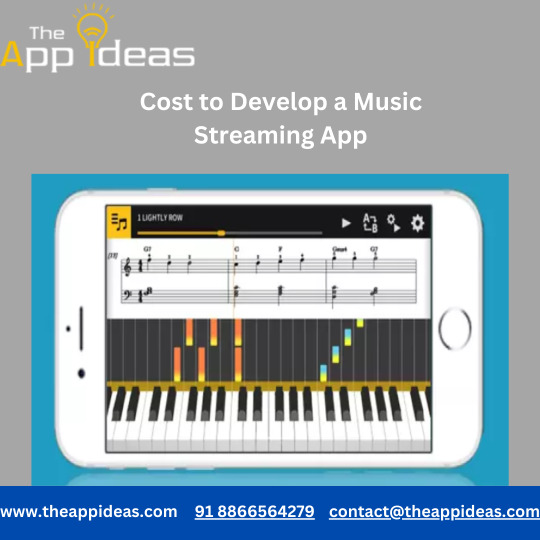
How Much Does it Cost to Develop a Music Streaming App?
Want to develop a music streaming app? Let's understand about music streaming app development costs & features & more in this blog.
https://theappideas.com/cost-to-develop-a-music-streaming-app/
#How Much Does it Cost to Develop a Music Streaming App#Music Streaming App#Music learning App#best Music leaming App
1 note
·
View note
Text
Rhythm in Your Pocket: Building a Music Streaming App with a Top Development Company

Get your groove on with Rhythm In Your Pocket! 🎶🎧 Our music streaming app, built by a top development company, offers seamless tunes at your fingertips. Enjoy personalized playlists, discover new tracks, and jam to your favorite beats anytime, anywhere.
Read More: https://www.techugo.com/music-streaming-app-development
#MusicStreaming #TopDevelopmentCompany #GrooveOnTheGo #PersonalizedPlaylists #DiscoverNewMusic #JammingAnywhere.
0 notes
Text
Pandora App Development Cost and Features

Users of the well-known music streaming program Pandora can design unique radio stations depending on their personal musical tastes. Since Pandora has been so famous over the years, a lot of advertisers and businesses want to develop their own versions of the software. Whether you're an entrepreneur or a company trying to enter the music streaming market, your success depends on your capacity to comprehend growth rate and monetization tactics.
Now before you delve into how much it costs to make an app like Pandora, take a look at what it really is and how it works…
Note: Are you thinking of creating a music streaming app like pandora? Then you need to contact Android application development in Virginia
What Is Pandora & How Does It Work?
Pandora was one of the first Music Streaming services from 2000. The platform originally allowed users to create virtual radio stations starting with the input of the user’s favorite song or artist.
The new app will offer new features such as song selection or playlists instead of classic radio stations, and it will also be possible to play songs offline by downloading them directly to a mobile device. Also notable is the new, improved interface for iOS and Android mobile apps; easy to use and with background color those change depending on the song being played and its cover.
Pandora Premium is starting its career in a market dominated by Spotify, with 50 million paying subscribers, and Apple Music, with over 20 million subscribers various, but will surely be of great use to all fans of Pandora's theoretical multimedia streaming system.
What Are Vital Factors to Take into Account When Creating a Pandora-Like App?
Any organizational objective must be accomplished with a well-thought-out plan. If you wish to create an app similar to Pandora, start by doing the following basic tasks:
UX/UI design
Having a beautiful and intuitive UI is very important for Mobile app development. Web and mobile apps should be intuitive enough that anyone can use them without training. In any case, you will want to enlist the help of a professional designer who can help you brainstorm and design excellent designs for your layouts.
A study by Stanford University found that the visual appeal of an app/website is the most important factor in consumers’ perception of its quality. Even the most functional app will suffer with poorly designed templates.
Place
Figuring out which countries will receive your services would be the next step. Broadband streaming services still cannot be seen everywhere due to internal restrictions and regional restrictions imposed by the government.
Choosing a good channel is essential since it will have far-reaching consequences for the company. It will be very difficult to break into the market, for example, if several competing services are already operating there.
Related Article: Mobile application development companies
Transmission of networks
If you want to start a music streaming service that is similar to Pandora, think about where and how you will keep your music.
Many data transfer and storage options are available depending on the project requirements, such as WEBRTC, RTMP, and cloud services. But these are very important features that will greatly affect app performance.
LicenseWithout a license, a streaming service cannot be started. Laws governing intellectual property would be broken if you did.
Pandora spends half of its revenue on music licensing fees. Check out the licensing requirements and fees for the country where you want to publish the app. If you have the right circumstances, it may be necessary to move out altogether.
Recommendation algorithm
The algorithm behind Pandora is a key factor in its success. The strategy by which listeners will identify the songs that best suit their tastes is something you should carefully consider. Basically, you can choose one of two paths.
Filtering input with group participation. Tracking everyone’s listening habits can reveal which albums and songs have the most spread.
Related Article: IOS application development companies in Washington
What Is The Price Of Building A Music Streaming App?
The app developer might not be able to foresee the total cost up front given that costs vary from product to product. A mobile app's development can be time-consuming and labor-intensive. Music app development companies typically charge by the hour, depending on the scope and complexity of the project.
The current standard range is from $30-$40 per hour which can be considered a good deal for this type of app. Costs also include paying UX/UI developers, Quality Assurance, and Testing Team as they are as important as back-end developers. The Cost to develop music streaming app like Pandora depends on location factors.
For instance, US-based companies that design apps charge hourly rates between $50 and $250, compared to $30-170 and $20-150 in Western and Eastern Europe, respectively. India is the most cost-effective choice in this sector; there, a mobile app developer can make products for between $10 and $80 per hour. Therefore, an Android- and iOS-compatible music streaming service will cost about $30,000 and $22,000 respectively.
Continuous innovation makes the cost of developing a Demand Music Streaming Mobile App cheaper in the coming years. So to become a profitable investment, one needs to spend a lot of money on various features that the previous apps are currently lacking and then deploy the App in real time to gain advantage.
Author: I’m Anita Basa, a fascinating Technical Content writer currently working at USM Business Systems. Interested to know about technology updates. Mobile App Development, IoT, Artificial Intelligence, Machine Learning, IOS, and Technology-related content Get connected with me on Linkedin
#mobile app development#app development company#music#Music streaming#listen listeners listeningtomusic listentothis lovethissong music#app development#ios app development#android app development#android app development company#ios app development company#mobile app development companies
0 notes
Text
i am literally unable to express how frustrating it is that privacy friendly and generally almost entirely better alternatives to apps like spotify exist but every single one of them is rendered effectively fucking useless to me because NONE OF THEM HAVE PLAYLIST FOLDERS! or for that matter, ANY means of organizing your playlists! like, look. i know how hard app development is, believe me. im sure there could be some esoteric reason implementing such a feature is dramatically harder than it appears. but i cannot help simply thinking, are these developers fucking stupid??? like it is such a basic and integral feature! there is no god damn way i and my mom are the only bitches on earth who make 300 playlists. please i am fucking begging you
#kingvirtueisdead#music#music streaming#streaming#streaming services#foss#foss community#free and open source software#open source#apps#software#software developers#software development
1 note
·
View note